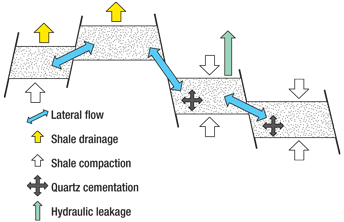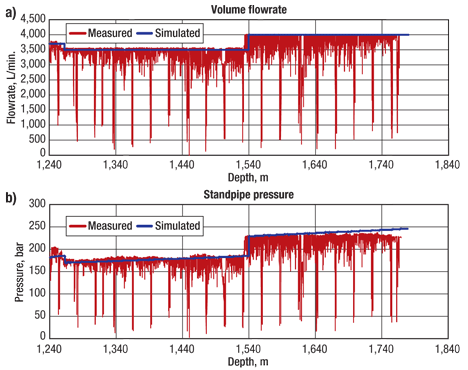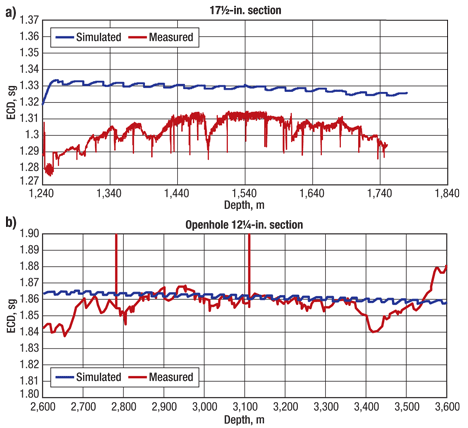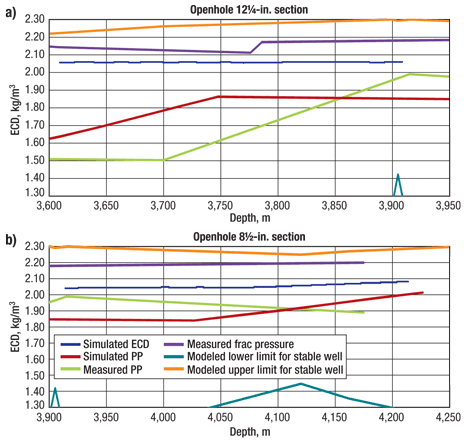Drilling experience with a small pressure window demonstrated the usefulness of ECD control and early kick detection.
Rolv Rommetveit, Sven Inge Ødegård and Christine Nordstrand, eDrilling Solutions; Knut S. Bjørkevoll, Pierre Cerasi and Hans Martin Helset, Sintef Petroleum Research; and Mikkel Fjeldheim and Stein T. Håvardstein*, Total E&P Norge
The Hild East high-pressure gas field is located in the central North Sea in production licenses P040 (Blocks 29/9 and 30/7) and P043 (Blocks 29/6 and 30/4). Water depth ranges 100–130 m.
Eleven exploration wells have been drilled in the area since 1975, six of them being discovery wells with gas condensate at high pressures. The first of these, with a Tertiary objective, was drilled in 1975. The other five, with Upper Jurassic objectives, were drilled between 1977 and 1983.
Hild East is the main horst structure of a series of faulted panels that bound the western side of the Viking graben. In 2003, a 3D seismic survey confirmed that the area is heavily faulted. These faults, combined with high pressures, complicate development of the gas and condensate.
Total E&P Norge AS, operating the P043 license with partners Statoil ASA and Petoro, is currently preparing several alternative plans for different full field development cases.
A very challenging high-pressure, high-temperature (HPHT) well was drilled using an advanced equivalent circulating density (ECD) management system including early diagnosis of upcoming problems and real-time simulations using state-of-the art models. Challenges to drilling the well included a very small window between pore and fracture pressure, which increased the probability of instabilities. Real-time modeling of stability during drilling mitigated this risk. Also, real-time ECD simulations were performed with an advanced hydraulic and thermal wellbore model, and pore pressure predictions were updated during drilling. The drilling experience demonstrates the usefulness of supervision and diagnosis functionalities.
WELL AND DRILLING CHALLENGES
The 30/4-D-1 AH well will appraise the Hild East structure. The strategy includes an S-shape pilot hole and a horizontal drain that will straddle two previously undrilled segments. If gas filled, the well will be completed as a pre-development well and tested by extended well test. The length of the horizontal section will be about 750 m.
At pilot well TD, the temperature is estimated at 140°C, with an uncertainty of ±5°C. The maximum pore pressure is 2.00 specific gravity (sg), with a rapid increase of 0.48 sg over a 150-m interval to the top of the Middle–Late Jurassic Brent group. The fracture pressure in the lower Shetland formations is 2.10 sg, leaving a very small mud weight window.
A gas kick in the horizontal section of the well could be difficult to detect at an early stage, and would also be difficult to circulate out, because a high flowrate would fracture the weaker formations above the reservoir.
Because of the small drilling window and the problems associated with handling a well control situation under these conditions, ECD control and early kick detection are of great importance for this well.
REAL-TIME ECD MANAGEMENT
The real-time ECD management and decision support system provided by eDrilling Solutions for this pilot well performs automatic supervision of the main elements of the drilling process. The concept uses all available real-time drilling data (surface and downhole) in combination with real-time modeling to monitor well conditions and provide guidance to optimize drilling. This information is visualized in real time in a graphical user interface.
The core of the system is an integrated drilling simulator capable of modeling in real time the different drilling sub-processes and their interactions. A set of advanced dynamic models calculate the well conditions based on available data.
In addition to calculating important properties such as pressure, ECD and torque, the system can also provide diagnostics, such as warning the user if there is danger of a kick or loss. Obviously, for these warnings to be representative of the well situation, it is very important that the data be reliable and up to date.
One of the main modules of the ECD management system is a multipurpose geopressure modeling tool called Pressim. Developed at Sintef Petroleum Research, this tool simulates all significant processes relevant to pressure generation and dissipation, Fig. 1. The simulator was developed to calculate pressure buildup and dissipation on a geological time scale in sedimentary basins.
 |
|
Fig. 1. Different processes simulated in the geopressure modeling module.
|
|
Data flow and infrastructure. The system infrastructure allows three different modes of operation: real-time, playback and what-if. Real-time data combined with well setup data is fed into the system via a real-time interface from the mud logging system. During operation, all results are logged to enable playback of results. The infrastructure also allows for what-if calculations based on the updated real-time models.
The graphical user interface (GUI) includes 3D and 2D outputs. The 3D GUI offers a real-time virtual view of the drilling process combined with diagnostic messages and advisory functionalities. The user can select between real-time, playback and what-if mode in the 3D GUI. The 2D GUI is an engineering and administration tool enabling the user to correct input data, and an analysis tool for the output data from the system.
During drilling, tripping and circulation, the main factors affecting ECD management include cuttings loading, transient thermal effects (axial conduction and radial convection), thermal and pressure effects on rheology and density, dynamic surge and swab effects, dynamic gel-breaking effects and thermal/pressure effects on wellbore stability. During displacement operations, circulation of multiple fluids with different and independent properties is also considered.
An automatic forward-looking module using the flow and temperature model continuously computes the expected ECD profile versus depth for the next drilling section for a given operational scenario. For roadmap generation and what-if mode, the user can remove the flow model from the system and perform a forward prediction for the preferred drilling scenario or plan.
Pre-modeling of well stability. The mud weight window as a function of measured depth is predicted using a wellbore stability model called Predicting Shale Instability (PSI), developed at Sintef. Input for the simulation runs rely on output from the pore pressure module, while the other parameters needed must be collected from laboratory tests on similar formations, interpreted data from nearby well logs and other sources. The work process is primarily to interpret available data and convert it to suitable input parameters for the software. Uncertainty in the central parameters leads to repeat runs where these parameters are modified, highlighting their impact on the obtained mud window. This provides a pre-drill estimation of the mud window versus depth. In addition, the stability model can be run at selected depths to calculate the evolution of the mud window with time, giving indications on the available period while drilling before a casing has to be set to avoid borehole instability.
The pre-drill prognosis is updated in real time during the drilling operation as LWD and drilling data becomes available; the latest geopressure modeling run provides an updated pore pressure value, which is applied to the existing mud window estimate.
Pre-modeling of pore pressure. Predicting pore pressure using the pore pressure model involves setting up and running the base model prior to drilling. A large number of model runs are performed as Monte Carlo simulations varying the important input parameters. This provides a pre-drill prediction of the most likely pore pressure versus depth with uncertainty ranges.
The pre-drill prognosis is updated in real time during drilling as LWD and drilling data becomes available. A statistical analysis of the pre-drill Monte Carlo results is performed to provide an updated prognosis of pore pressure ahead of the drillbit in real time.
 |
|
Fig. 2. a) Flowrate used as input in the model plotted versus measured flowrate. b) Simulated versus measured standpipe pressure.
|
|
HYDRAULIC AND ECD MODELING
For the 17½-in. section of the 30/4-D-1 AH well, an offline simulation of the hydraulic data was performed and compared with the real measured values. With the same flowrate, the standpipe pressures follow quite closely, Fig. 2. But when it comes to ECD there is a distinct difference, Fig. 3a.
 |
|
Fig. 3. Simulated versus measured ECD for a) the 17½-in. section and b) the openhole12¼-in. section.
|
|
Some of this difference is likely caused by generic mud data used in the simulations, as real mud data for this well was not yet available. But the measured ECD is often lower than the mud weight of 1.3 sg, indicating either poor control of the mud properties while drilling or that the logging instrument is wrongly calibrated. When the hydraulic simulations are done in real time with automatic update of flow and mud properties, it is possible to determine the cause of such discrepancies. It is also possible to get updated accurate values for the ECD at the shoe or at other weak formations of interest while drilling.
For the 12¼-in. openhole section, the simulated ECD is much closer to the measured; this is due to much better mud property input data for modeling in this case, Fig. 3b.
Pre-drill simulations have been done for the 121/4-in. and 81/2-in. reservoir sections of the pilot hole on this well. The ECD is plotted together with the prognosed profiles for pore pressure and fracture pressure, Fig. 4. These simulations show that the operator was within the various limits for hole stability while drilling the reservoir.
 |
|
Fig. 4. Simulated ECD for (a) the 12¼-in. section and (b) the 8½-in. section plotted with the different boundary limits based on modeling done prior to drilling and based on data acquired while drilling.
|
|
Later in the drilling program, some of the reservoir will be drilled with a coring assembly. This assembly has less clearance, and it does not have a pressure tool to measure the ECD. Due to these challenges, the availability of real-time updated ECD simulations will be of great importance to this well. 
ACKNOWLEDGMENT
This article was prepared in part from IADC/SPE 128648 presented at the IADC/SPE Drilling Conference and Exhibition held in New Orleans, Feb. 2–4, 2010..
|
THE AUTHORS
|
 |
Rolv Rommetveit is the Managing Director for eDrilling Solutions. He has more than 20 years’ experience in R&D in drilling and well technology, with emphasis on drilling hydraulics, well control, MPD and automated real-time decision support and control during drilling. Dr. Rommetveit has an MSc degree in physics from the University of Trondheim in Norway and a PhD in applied mathematics from the University of Bergen, also in Norway.
|
|
| |
Christine Nordstrand is a Drilling Engineer for eDrilling Solutions. Her main focus is drilling mechanics and drilling optimization. Ms. Nordstrand joined eDrilling in May 2009. She has a Cand. Scient. degree in petroleum geophysics and geology from the University of Bergen. |
|
| |
Knut Steiner Bjørkevoll has been Senior Scientist, Project Leader and Research Director at Sintef Petroleum Research since 2004. He worked as a Senior Scientist in Rogaland Research from 1992 until 2004. His accomplishments include development of integrated mathematical models for drilling operations, analysis of drilling data, model-based real-time decision support and drilling automation.
|
|
| |
Pierre Rolf Cerasi is a Senior Research Scientist at the Formation Physics department of Sintef Petroleum Research, leading projects related to sand production, sand control and formation damage. He joined Sintef in September 2000. Dr. Cerasi has a PhD degree in physics from the University of Paris VII in France, with an option in biomechanics.
|
|
| |
Hans Martin Helset is a Senior Research Scientist in the Basin Modeling group at Sintef Petroleum Research. He has 15 years of R&D experience in the petroleum industry, with his main research areas including fluid flow and pressure modeling in sedimentary basins, rock physics and petrophysics. The focus of his work has been on developing new models and methods to be used in exploration and drilling. He has an MSc degree in physics from the Norwegian University of Science and Technology and a PhD degree in physics from the University of Bergen.
|
|
| |
Mikkel Fjeldheim is a Drilling Engineer with Total E&P Norge AS, with 18 years of drilling and production experience. He has an MSc degree from the University of Trondheim.
|
|
| |
Stein T. Håvardstein is a Senior Drilling Engineer for Nexen Exploration Norge AS, with 12 years of oilfield experience focused on drilling engineering decision support and wellbore positioning. Before joining Nexen, he worked for Total E&P. He has an MSc degree in petroleum technology from the University of Stavanger.
|
|







